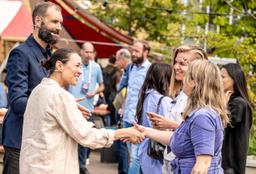
3 questions to Linshan Feng on QDNL white paper (2/3)
Lessons from AI – Communication
Following the first white paper on Stakeholder Engagement from the ‘Lessons from AI’ series that was published last November, the second paper on Communication is now available for download. We asked 3 questions to contributor Linshan Feng.
Linshan is a master’s student in Biology and Science Communication and Society at Leiden University and a student assistant for QDNL.
This second of three white papers was written by Linshan Feng, Julia Cramer and Ulrich Mans.
Why is it important that we start talking about the communication of quantum technologies?
Quantum technologies are currently moving from the realm of research toward practical applications. These applications could have societal consequences and the public needs to be informed and involved in a conversation about them as soon as possible. Starting too late can make effective communication more difficult in the future. In this white paper series, we looked at the communication efforts on artificial intelligence, which are still ongoing 20 years after AI technologies have transitioned from research to application.
Now that AI applications are virtually everywhere, people have become more interested in learning about them, but misconceptions about what AI can do are already widespread. Starting the conversation on communication on quantum technology already now could make it easier to establish an accurate public understanding of quantum and facilitate productive discussions with the public about how the technology should be implemented.
What is in your view the most important lesson on communication that quantum technology can learn from AI’s entrance into society?
One very important point raised by experts was that we need to talk about the many stakeholders involved in developing and implementing AI technology. People should know that AI applications are tools and that stakeholders can influence how they will be used and what impacts they will have.
Reports about AI often make the AI tool sound like the main culprit when something goes wrong. However, the problem often lies in how it was further developed or applied by people instead. Elucidating important stakeholders could encourage and enable the broader public to hold them accountable to create applications that are in line with societal needs and rules.
What do you want people to do after reading this white paper?
First, I hope that it will inspire more people to get involved in the communication efforts of new technologies such as quantum or AI. AI communication is already a diverse field in which people from corporate, governmental, institutional and journalism backgrounds are involved. There are many sides to technology and many different audiences that have different needs. We need more people to start communicating quantum to their chosen audience so that we can involve as many people as possible in the implementation process.
Secondly, I hope that the points can inspire fruitful conversations about guidelines or best practices for communicating quantum in the future. In AI communication, picture repositories have recently started to counter the pervasive and often unhelpful illustration of AI algorithms as either robots or zeros and ones. For quantum, most people don’t have an image in their heads yet, so it is the right time to start discussing how we want people to imagine quantum technologies.
Download the full white paper here:
Read more
Related articles about QDNL white papers – Lessons from AI
